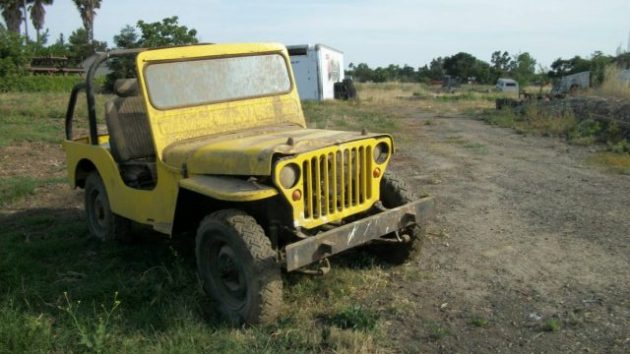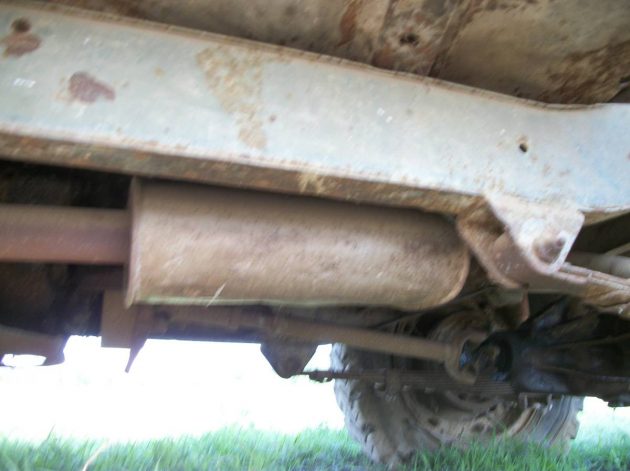It’s hard to tell from the pictures if this is a Willys MB or a Ford GPW. The Willys engine is a replacement, so that’s no help. By 1942 Willys was using a stamped grill like the Ford instead of the flat bar grill. This old Jeep is listed on craigslist in Rio Linda, California for a modest $2,750. It’s been in the barn for about 20 years. There’s not much information or many pictures included with the ad.
The engine is not frozen and doesn’t have many miles on it since it was replaced. It’s been updated with an alternator and distributor ignition.
It looks solid under here, but this picture doesn’t show much. It would be good to have a look underneath and from the top side. Among other problems the body attach points often rust . If the tub is rusty and needs extensive repair, a reproduction body is between $2500 and $3000. Someone will probably buy this for a hunting jeep, but it would also be cool to restore it, at least cosmetically, to an army Jeep. We have one at the museum and it gets lots of attention, especially when we use it for special events. What would you do with it? Can you tell if this is a Ford or a Willys from the pictures? Is the first cross bar under the grill a curved tube (Willys) or a “U” channel? (Ford) Your comments are going to be very interesting.





I’m guessing the data plates are missing or the seller likely would have taken a pic. Hard to see the front crossmember to be able to tell if Ford or Willys.
Willys jeep civilian the reason for thinking is the military had square windshields… I maybe wrong
The grill is definitely military. The windshield frame is from a CJ-3A or an M38. A good way to tell if it’s a Ford is to check for the “F” on the bolt heads. Ol’ Henry specified that for the Ford models.
The windshields from these “flatfender” jeeps all interchange and are often swapped out.
Could be an MB but the looks like it may also have been cobbled together from pieces. Not an MB windshield as noted above, i don’t think that the MB’s had the slot on the or in the body where the foot wells were until later , maybe CJ, of course the the word jeep on the engine was not used until after the war, a word made up from “GP” or General Purpose, or GPW in the case of a Ford meaning General purpose Willys. The back end looks like it is galvanized steel? I memory is the Ford had a square tube,not a U, but… Really hard to say anything for sure without better photos. I loved mine when i was 14-17. So much fun.
Poor pictures for ID purposes, but there are some clues. Most of it looks like a civilian cj2a with a MB/GPW grille and cj3a windshield. Rear wheelhousing tubs on this body have ribs on them with no toolbox lids visible; MB and GPW’s have flat metal on the top of the tubs with 2 toolboxes built into the back of the body. Also,the corner gussets on the front of the rear wheel tubs are not as angled as they are on the mb/gpw’s. The panel that is covering the rear of the jeep appears to be galvanized metal, not regular steel. Those are civilian top bow brackets on the tub corners. Also note the the punched hole visible on the firewall to the left of the motor thats one of the holes for the heater in the civilian models. Rear axle is a full floater and could be from a mb/gpw or an early civilian cj2a. The block maybe from a military jeep, but it has a post ’47 head on it and all the other accessories visible are from civilian jeeps (except the alternator). A few more pics would be good; would like to see if it has a glovebox, a gun pedestal on the rear part of the frame and where the gas tank filler is. .
I vote for early CJ with a few military bits.
Had a ’42 Ford ex Air Force Jeep. One difference between the two was the Ford had a solid back panel… no tail gate like the Jeep. If that panel is original it’s a Ford.
Neither the Willys MB or the Ford GPW had tailgates. Tailgates appear when they built the prototype CJ2’s and were standardized on the civilian CJ2a.
Hess ’42 Ford Jeep. Notice the windshield….
Nice looking jeep Bob. I like that plow and the hardtop. Interesting that your jeep had drain holes on the side panels……that didn’t appear on jeeps until the civilian models came out. Possibly added later or did someone replace those front panels at one point due to rust or damage?? Any views of the other side? Also interesting that all of the grab handles are missing. I wonder if someone didn’t try to “civilianize” it, which was popular back in the day.
The Willys has a round tube front cross member. The Ford has a “top hat” section. The Willys version is too stiff compared to rest so it cracks where it meet the chassis. Don’t weld it, just put stop drillings at the end of the cracks.
The rear “A” frame members to the pintle hook have punched holes on Ford.
The rear shock mounts on the Willys are folded. On the Ford the look like stamped cups welded together face to face.
Every Ford part will have an “F” scroll on it. Even the spring washers!
My Jeep is all Ford, but for the chassis. I have it from the experts here that the 2 companies sometimes swapped parts during manufacture if supplies ran low, so in the end you can’t really tell.
Hey, Rustowner…Good info. Owner we bought it from did the top and probably did the handle removal. Ax bracket, handles. etc. were all gone. Top was 1/4″plywood with a thin layer of fiberglass on each side. It was a pretty piece and much needed in the upper portion of the lower peninsula of Michigan. Plow we built was a 55 gallon drum cut in half with welded up supports and the hydraulic cylinder and hand pump from a Hawk missile site. He actually put a small heater in it that worked a lot better than it should have. None of the bodywork or mechanicals had been replaced and there was no rust as he kept it in a garage the whole time he owned it. With the exception of a main bearing we did nothing to get on the road. Paperwork from the Air Force Confirmed their purchase in 1942. Great fun!
I believe the willys always had the seven slot grille once they went to vertical bars.
The military models have swing over head lights that let you illuminate the engine bay (like this appears to have). The civilian ones mount fixed headlights in the grill.
The distributor and radiator are missing. Not a good sign as dirt and rain can enter the engine with a missing distributor.
The oil pump runs off the same skew gears as the distributor. I’d be a bit dubious about the condition of the engine.
Later CJ’s had the “F” head engine and taller hood. This one has an “L” head.
The early post war military engines have a slightly different “L” head with a whole lot more emission control plumbing and a waterproof carburettor for fording.
The military models have fully floating axles with the forged one piece flange on the outboard end. Civilian ones don’t.
Never seen the tub drains on a military version in Australia.
Later military versions have the spade and axe indents on both sides of the tub and the fuel filler on the outside. The fuel filler is under the seat on the WWII ones.
I believe thats a continental engine. Ford used the tractor engines.
Hi, Actually American Bantum built over 1600 Jeeps, mostly for British and Russian export. They had a slightly different look to the front fenders though, and perhaps other differences I am unaware of. Be fun to find one. I did once have a Bantum trailer. :-) Terry J
It’s the Willys pattern motor made by both Ford and Willys for all the WWII production. It was based on the pre war Willys car engine and was slightly bigger than the competing tenderers. It seems it was the final reason the military chose Willys for the production model. The prototypes from Bantam and Ford had the Continental and Fordson engine.
At least they didn’t mess with the headlights. I see so many, with the larger headlights, that were added later.